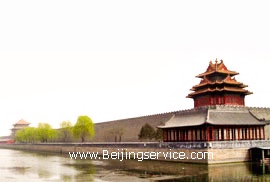Home / Beijing Tour / Beijing Private Tour / Beijing Discover / Beijing Attractions :
Treasures in Forbidden City
Introduction of Treasures in Forbidden City
Introduction
Architecture
Construction
Present condition
Treasure
Forbidden City tour
more ...
Countless and priceless treasures are on display in Forbidden City. The following are but a few of them:
Imperial seals
The 25 imperial seals were made of such materials as jade, gold of sandalwood. There is a handle on the top of each seal in the shape of dragons in various postures.
 Ivory Mat
Ivory Mat
The Ivory Mat is 2.16 meters (6ft 10in) by 1.39 meters (4ft7in) and woven of ivory filaments less than three millimeter (0.12 inches wide and 1 millimeter (0.04 inch ) thick. Five ivory mats were made during the reign of Yongzhen. Three of them have remained till now.
Jade Carving of "dayu Harnessing Floods"
Jade Carving of "dayu Harnessing Floods" is the largest piece of jade carving in China today. It is 2.24 meters (7ft4in) high and weighs five tons. It was quarried in Xinjiang, Northwest China, and transported to Yangzhou for carving. When the carving was done, the jade piece was shipped to Beijing. Transportation and carving altogether took ten years. Two other big pieces of jade carving on display are also very famous. One is a big jade jar with the carving of sea waves, meaning the emperor's happiness was as endless as water in the Eastern Sea. The other is a mountain with pine trees, representing the emperor's life as long lasting as the old pine in the southern Mountain.
 Ruyi was made of stone, bone, metal, jade coral, lacquer, etc., and used to be just a scratch back in the early days. During the Qing Dynasty, it became a symbol of good luck and ornament. On such festive occasions as the emperor's coronation and birthday, the ministers and princes would present ruyi to the emperor as a gift, and the emperor would also give ruyi to his official and his favorite concubines. While the young emperor was choosing his wife, he would convey his affection by giving ruyito the girl he liked best. ruyi was also used as a kind of decoration in the halls and placed by the throne in the imperial palace.
Ruyi was made of stone, bone, metal, jade coral, lacquer, etc., and used to be just a scratch back in the early days. During the Qing Dynasty, it became a symbol of good luck and ornament. On such festive occasions as the emperor's coronation and birthday, the ministers and princes would present ruyi to the emperor as a gift, and the emperor would also give ruyi to his official and his favorite concubines. While the young emperor was choosing his wife, he would convey his affection by giving ruyito the girl he liked best. ruyi was also used as a kind of decoration in the halls and placed by the throne in the imperial palace.
Great Wall tour
Beijing private tour
Xingang Beijing tour
Beijing one day tour
Beijing package tour
Beijing join in tour
![]() Beijing Tour Related
Beijing Tour Related
Beijing pictures
Beijing discover
Beijing highlights
Beijing attractions
Travel Beijing toolkits
Beijing Tour Knowledge
#.Question: Which hotel you suggest when i plan a trip to Beijing?
#.Answer:
We suggest Beijing Prime Hotel (5 star), Holiday Inn Temple
...
Travel Beijing Tookit
| Home | About us | Contact us | Link to us |
Copyright @ www.Beijingservice.com since 2003 Beijing Xindong International Travel Service

